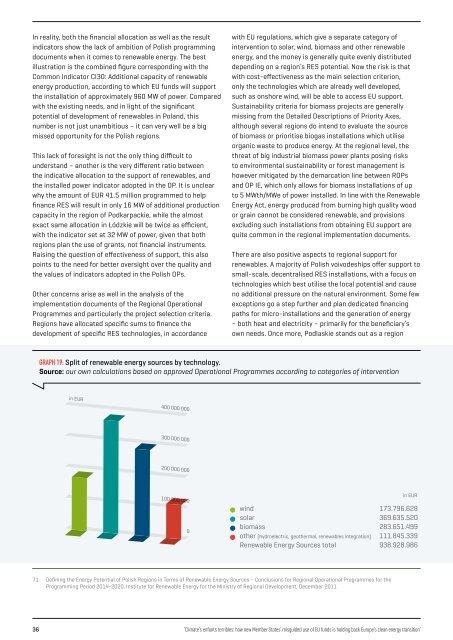ENFANTS TERRIBLES
enfants-terribles
enfants-terribles
Create successful ePaper yourself
Turn your PDF publications into a flip-book with our unique Google optimized e-Paper software.
In reality, both the financial allocation as well as the result<br />
indicators show the lack of ambition of Polish programming<br />
documents when it comes to renewable energy. The best<br />
illustration is the combined figure corresponding with the<br />
Common Indicator CI30: Additional capacity of renewable<br />
energy production, according to which EU funds will support<br />
the installation of approximately 960 MW of power. Compared<br />
with the existing needs, and in light of the significant<br />
potential of development of renewables in Poland, this<br />
number is not just unambitious – it can very well be a big<br />
missed opportunity for the Polish regions.<br />
This lack of foresight is not the only thing difficult to<br />
understand – another is the very different ratio between<br />
the indicative allocation to the support of renewables, and<br />
the installed power indicator adopted in the OP. It is unclear<br />
why the amount of EUR 41.5 million programmed to help<br />
finance RES will result in only 16 MW of additional production<br />
capacity in the region of Podkarpackie, while the almost<br />
exact same allocation in Łódzkie will be twice as efficient,<br />
with the indicator set at 32 MW of power, given that both<br />
regions plan the use of grants, not financial instruments.<br />
Raising the question of effectiveness of support, this also<br />
points to the need for better oversight over the quality and<br />
the values of indicators adopted in the Polish OPs.<br />
Other concerns arise as well in the analysis of the<br />
implementation documents of the Regional Operational<br />
Programmes and particularly the project selection criteria.<br />
Regions have allocated specific sums to finance the<br />
development of specific RES technologies, in accordance<br />
with EU regulations, which give a separate category of<br />
intervention to solar, wind, biomass and other renewable<br />
energy, and the money is generally quite evenly distributed<br />
depending on a region’s RES potential. Now the risk is that<br />
with cost-effectiveness as the main selection criterion,<br />
only the technologies which are already well developed,<br />
such as onshore wind, will be able to access EU support.<br />
Sustainability criteria for biomass projects are generally<br />
missing from the Detailed Descriptions of Priority Axes,<br />
although several regions do intend to evaluate the source<br />
of biomass or prioritise biogas installations which utilise<br />
organic waste to produce energy. At the regional level, the<br />
threat of big industrial biomass power plants posing risks<br />
to environmental sustainability or forest management is<br />
however mitigated by the demarcation line between ROPs<br />
and OP IE, which only allows for biomass installations of up<br />
to 5 MWth/MWe of power installed. In line with the Renewable<br />
Energy Act, energy produced from burning high quality wood<br />
or grain cannot be considered renewable, and provisions<br />
excluding such installations from obtaining EU support are<br />
quite common in the regional implementation documents.<br />
There are also positive aspects to regional support for<br />
renewables. A majority of Polish voivodeships offer support to<br />
small-scale, decentralised RES installations, with a focus on<br />
technologies which best utilise the local potential and cause<br />
no additional pressure on the natural environment. Some few<br />
exceptions go a step further and plan dedicated financing<br />
paths for micro-installations and the generation of energy<br />
– both heat and electricity – primarily for the beneficiary’s<br />
own needs. Once more, Podlaskie stands out as a region<br />
GRAPH 19: Split of renewable energy sources by technology.<br />
Source: our own calculations based on approved Operational Programmes according to categories of intervention<br />
in EUR<br />
400 000 000<br />
300 000 000<br />
200 000 000<br />
100 000 000<br />
0<br />
in EUR<br />
wind 173.796.628<br />
solar 369.635.520<br />
biomass 283.651.499<br />
other (hydroelectric, geothermal, renewables integration) 111.845.339<br />
Renewable Energy Sources total 938.928.986<br />
71<br />
Defining the Energy Potential of Polish Regions in Terms of Renewable Energy Sources – Conclusions for Regional Operational Programmes for the<br />
Programming Period 2014-2020, Institute for Renewable Energy for the Ministry of Regional Development, December 2011<br />
36<br />
‘Climate’s enfants terribles: how new Member States’ misguided use of EU funds is holding back Europe’s clean energy transition’


